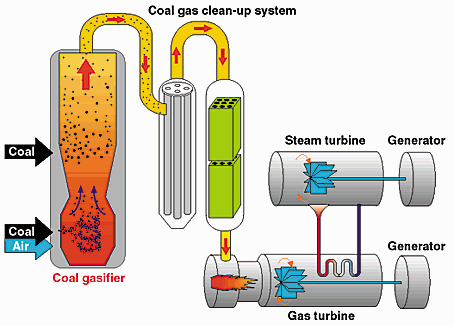Let's Remove the Radioactive Metals Spewing Out from Coal-fired Power Plants!
Did the title to the blog get your attention? Good - a bit misleading to start, but bear with me and you'll find I'm not pulling your leg here.
This isn't the first time I've written about this, in fact either indirectly or directly I've written about it twice before. What has me on it again is Sunday's article in the Times, 2 Industry Leaders Bet on Coal but Split on Cleaner Approach. As you might guess the "cleaner" approach is tied to Integrated Gasification Combined Cycle Technology (IGCCT), and as you might otherwise guess it's on the losing end of the split.
I first ran into IGCCT in a Times article back in May of last year, Dirty Secret: Coal Plants Could Be Much Cleaner. Knowing that at present coal provides about 50% of the energy for producing electricity in this country, that with the increasing cost of a barrel of oil the option of using coal even with its traditional dirty reputation goes up, and, most importantly, that this country is presently an exporter of coal and has enough of the stuff to meet a significant portion of our overall energy needs in one form or another into the next 100 or so years, I therefore know that ignoring something like this isn't smart. No matter how much any of us don't like coal there's nothing coming anytime soon that'll replace it so finding more "green" ways of using the stuff does seem like a smart move - that's where IGCCT comes in.
Here are some of the particulars on IGCCT from last year's Times article:
The operating savings of such plants start with more efficient combustion: they make use of at least 15 percent more of the energy released by burning coal than conventional plants do, so less fuel is needed. The plants also need about 40 percent less water than conventional coal plants, a significant consideration in arid Western states.
... the primary virtue of integrated gasification combined-cycle plants is their ability to chemically strip pollutants from gasified coal more efficiently and cost-effectively, before it is burned, rather than trying to filter it out of exhaust.
Proponents say that half of coal's pollutants - including sulfur dioxide and nitrogen oxides, which contribute to acid rain and smog - can be chemically stripped out before combustion. So can about 95 percent of the mercury in coal, at about a tenth the cost of trying to scrub it from exhaust gases racing up a smokestack.
The biggest long-term draw for gasification technology is its ability to capture carbon before combustion. If greenhouse-gas limits are enacted, that job will be much harder and more expensive to do with conventional coal-fired plants. Mr. Lowe, the G.E. executive, estimated that capturing carbon would add about 25 percent to the cost of electricity from a combined-cycle plant burning gasified coal, but that it would add 70 percent to the price of power from conventional plants.
As far as the carbon dioxide that results from these plants is concerned that's still a problem, but with IGCCT it's easier than it would be with a standard coal-fired plant to adapt the plant to some mode of sequestering, should such a mode be found. But let's look at this apart from the CO2 issue: More efficiency, less acid rain, and less mercury. Mercury wouldn't be the only heavy metal you could more easily scrub from the plant's gas emissions and the fact is that we'd all be interested in pulling out radioactive heavy metals, which occur naturally in coal as well. Oh, you weren't aware of this? Gee, go to Coal Combustion (an Oak Ridge National Laboratory paper posted to their web site, for those of you immediately skeptical of where I'm heading here) and you'll find the following:
Former ORNL researchers J. P. McBride, R. E. Moore, J. P. Witherspoon, and R. E. Blanco made this point in their article "Radiological Impact of Airborne Effluents of Coal and Nuclear Plants" in the December 8, 1978, issue of Science magazine. They concluded that Americans living near coal-fired power plants are exposed to higher radiation doses than those living near nuclear power plants that meet government regulations. This ironic situation remains true today and is addressed in this article.
The article, while not talking directly about IGCCT (the technology hadn't been considered for coal-fired plant use when this article was written in 1978), mentions that it'd be possible to pull the radioactive metals out from the stack emissions with technology that existed back then.
So, however you cut it, with the fact that coal isn't going away anytime soon and there's a strong likelihood that it's use in this country will increase, what would you rather have, a traditional coal-burning power plant, or one that uses IGCCT to burn that coal? Well, you'd think that this was something of a no-brainer, at least I certainly would, but no, that's not the case at all. Which brings us to the article in yesterday's Times, Industry Leaders Bet on Coal but Split on Cleaner Approach - New York Times. Michael Morris represents one perspective in the coal-power industry: while IGCCT may be initially 15 to 20% more expensive to build than regular coal-fired plant they're the right thing to do for reasons to do with the expected eventual imposition of carbon caps, something that will strongly bear on the energy-producing sector in this country, and because on the whole the things are just plain better investments when it comes to greater efficiency and green-friendliness, something that consumers are increasingly concerned with.; it's also believed that over time the plants will re-coup their higher cost. The other side to this issue is represented by Gregory Boyce for whom there's not enough proof to justify anything IGCCT brings to the table. Boyce clearly represents how we're doing business in this country as of the 140 new coal-fired plants to be built in the coming years, only 12 will use IGCCT.
This blog post is a bit longer than I expected, so I'll cut to the chase here: Boyce and his crowd tend to throw out two things to justify their position. In this case one of those things Boyce specifically throws out to justify his take on where coal-fired plants should be going, i.e.:
Mr. Boyce was chairman of an advisory panel for the Energy Department, organized by the National Coal Council, that produced a controversial report in March calling or exemptions to the Clean Air Act to encourage greater consumption of coal through 2025. The thrust of the report, which Mr. Boyce outlined in an interview, is that improvements in technology to limit carbon dioxide emissions should be left to the market instead of government regulation. [Italics added by the blogger.]
I love this - the market, NOT government which specifically represents the majority of the people and their collective interests, should determine whether we primarily invest in IGCCT or not. How does Mr. Boyce measure when the market has made its determination, and what specific part of the market is he looking at? It can't be the fishing "market" which finds itself having to work under a government recommendation that pregnant women and young children eat no more than 1 helping of fish per week due to the mercury found in fish these days. Of course that mercury will continue to come from Mr. Boyce's new plants as it does from his old ones.
The second argument in favor of the status quo with regard to coal-fired plants is that third world countries don't have to meet the more stringent environmental standards and our doing so costs us money, so why should we? This is the quintessential Republican line, the party of Christianity, where "do for others" is somehow lost in the Christian message. We had over 100 years to foul the environment and the air with our industrial detritus, it seems to me that both India and China, and any other third world country for that matter, should have some time to get themselves on their feet before they're expected to meet a standard that a conscientious and concerned rich first-world country should be able to meet without too much hassle; of course I'd be wrong about the leaders in the "concerned first-world country I happen to live in.
Coal is not going to go away, and using it conscientiously and with concern for the environment demands we use technology such as IGCCT. No, the market should not be what makes this decision as the market is a mystery to me, as it well is to anyone who tries to follow and understand it, and I would much rather have some input and control over my future, not leaving it to some invisible hand which cares not a wit, and why should it really, for my existence or that of those I love. If we're going to use coal, and God knows it's likely a deluded person who thinks we won't, then we should be using IGCCT and doing what we can to influence decisions in that direction.


0 Comments:
Post a Comment
<< Home